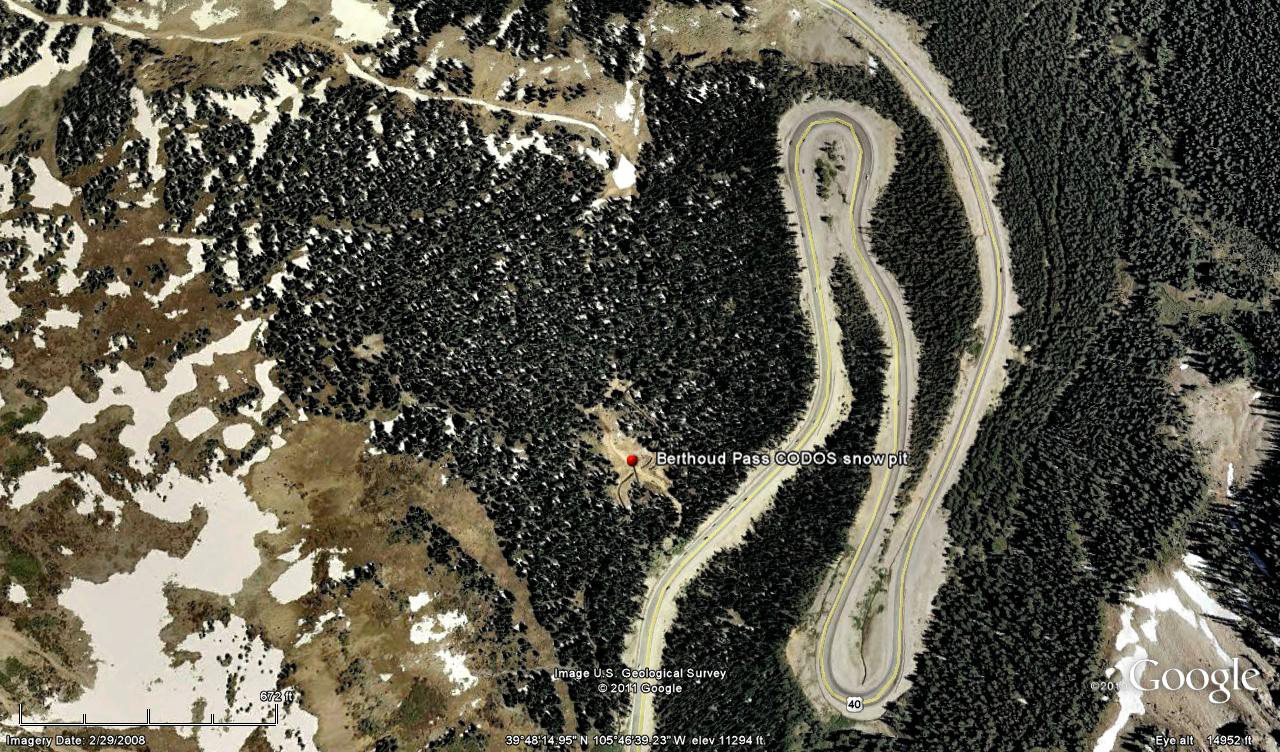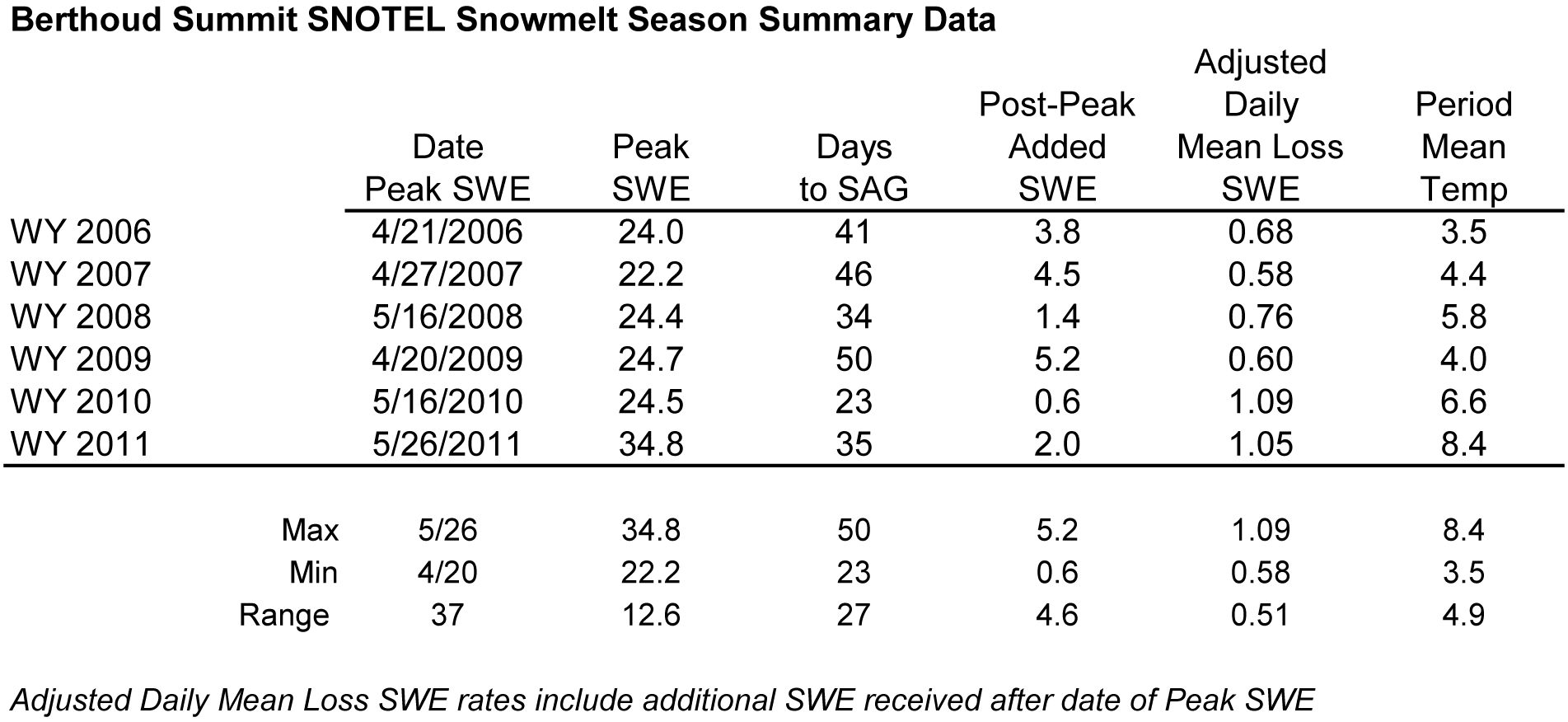 CODOS Update for Berthoud Summit:
CODOS Update for Berthoud Summit:
March 28, 2012
Summary |
Snowpack |
Melt Rate |
Stream Flows |
Forecast |
Previous Update |
pdf
Summary
Colorado’s substantially sub-par reservoir of SWE now contains two significant (D5 and D4) and one minor (D6) dust layers at/near the snowpack surface statewide, and is vulnerable to continued prolonged periods of dry, sunny weather combined with reduced snow albedo. This Update presents site-by-site and summary analyses of snowmelt rates at CODOS and other Snotel sites for Water Years 2006-2011.
Snowpack conditions in this portion of the upper Fraser River watershed are likely still mixed, with some cold content persisting in alpine and higher sub-alpine terrain snow at the same time that the lowest remaining snowcover in Middle Park is isothermal and releasing snowmelt runoff. Merged dust layers D5/D4, and possibly D6, are reducing snow albedo throughout this locale and the Berthoud Summit Snotel site has shown a recent decline in SWE. Should dry weather continue to dominate this spring season, and dust-enhanced snowmelt rates approach the average or maximum rates discussed below, snow all gone (SAG) may occur early at this Snotel site producing early peak streamflows, early passage of runoff center of mass, and steep descending limbs on local hydrographs.
SnowPack Discussion
We have no new first-hand snowpack observations to present. Our next visit to the Berthoud Summit site will be in early April, as weather and dust conditions dictate.
Melt Rate
The table below presents Water Year analyses of snowmelt behavior at the Snotel station adjoining this CODOS site beginning with WY 2006. The date of Peak SWE and subsequent number of days to “snow all gone” (SAG) are shown for each Water Year. Then, the amount of additional SWE received after the date of Peak SWE is added to Peak SWE to calculate an “adjusted daily mean loss [of] SWE” rate during the snowmelt season that Year. Finally, the mean air temperature during the period from Peak SWE to SAG, as measured at the Snotel site, is shown for each Water Year. A current Snotel plot is presented below the table. The intent of this table is to refresh memories of snowmelt rates during the past several dust-influenced Spring seasons, and to assess this year’s snowpack conditions in light of those past years.
As of Tuesday, March 27, 2012, the Berthoud Summit Snotel reports a loss of 0.9” SWE since March 21. This recent melt rate falls well short of the mean daily loss rates shown in the table below, and very far short of the maximum SWE loss rate last Spring of 1.46” per day, over a 5-day period ending June 12, 2011. As has been discussed in prior seasons, because of its location in an open meadow, with good sky view to the east and south, Berthoud Summit Snotel data do capture the influence of dust-on-snow in open terrain (versus in tree cover).
Stream Flows
The USGS Fraser River Upper Station near Winter Park stream gauge is reporting a recent rise in streamflows, nearing the 32-year period of record peak flows for this date set in 2004.
Forecast
As of Tuesday afternoon forecasters at the Grand Junction National Weather Service anticipate continued warm and generally dry weather through the remainder of this week, with the warmest temperatures of the week on Saturday. The northern mountains may experience some light showers and more cloudiness than the southern half of the state. Snowmelt rates are likely to continue to increase through Saturday.
By Saturday afternoon an approaching trough and associated cold front are expected to generate another episode of strong pre-frontal SW’ly winds for the State. Winds will sustain and become W’ly on Sunday. Dust source areas in the Colorado Plateau may yield to these SW’ly and W’ly winds and produce another dust event beginning Saturday afternoon. This weekend’s cold front may, once again, not deliver a significant winter storm. However, a return to cooler, more seasonable temperatures by Sunday/Monday does seem likely. In the absence of new snow with this weekend cold front, a dry D7 event, should it occur, would generally fall directly onto already exposed and merged D6/D5/D4 dust, further reducing snowpack albedo throughout the Colorado mountains.

